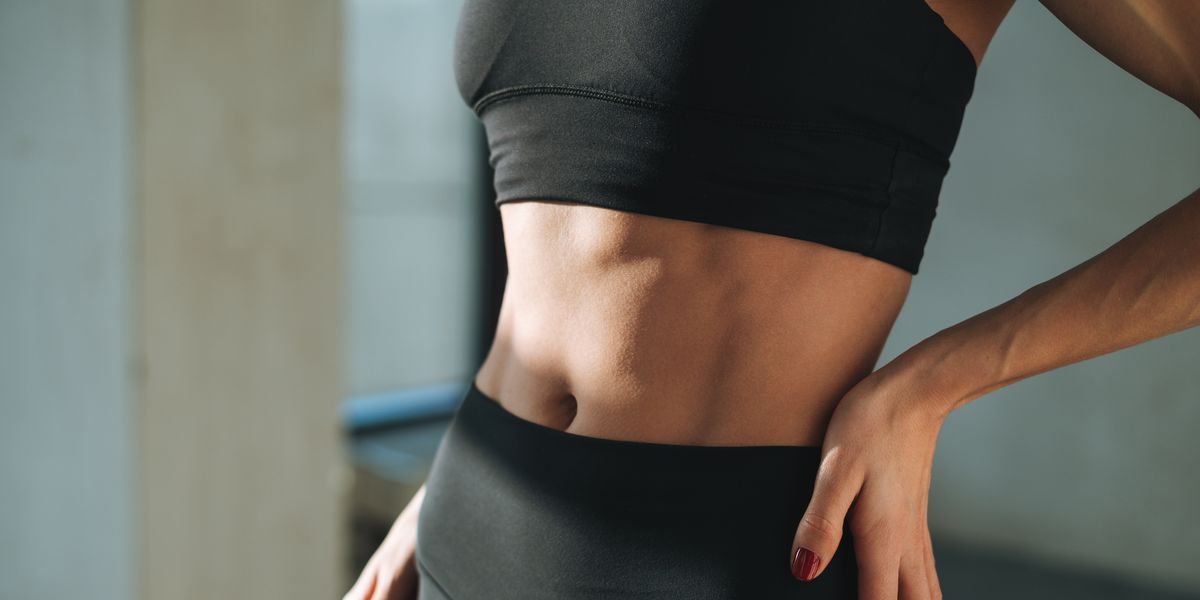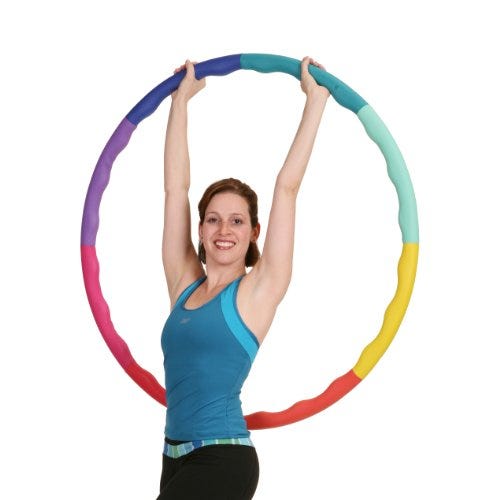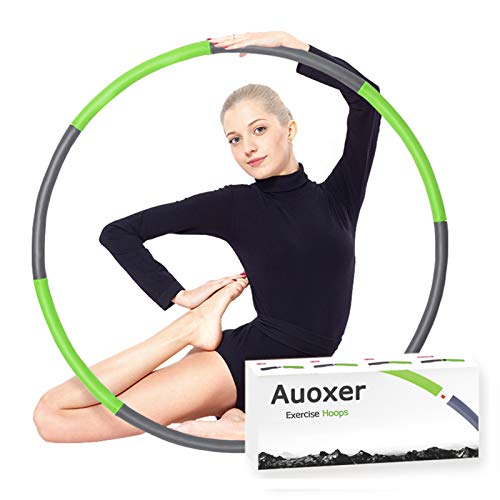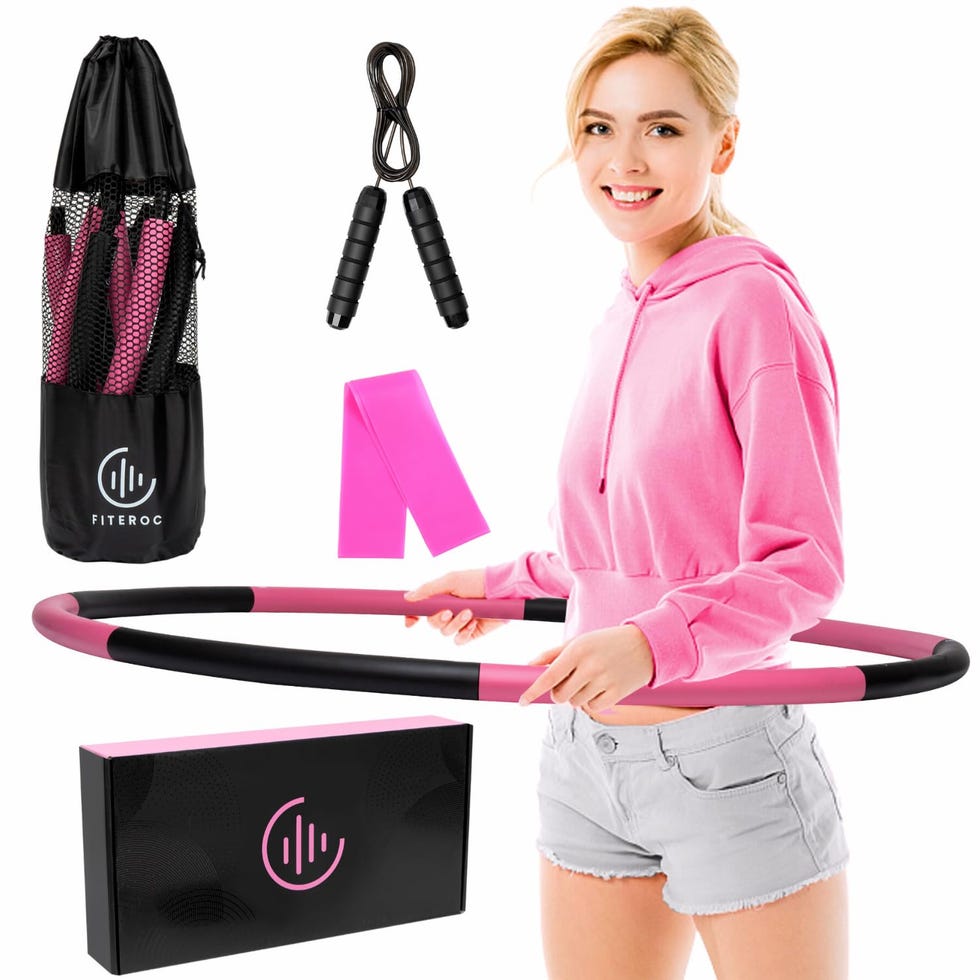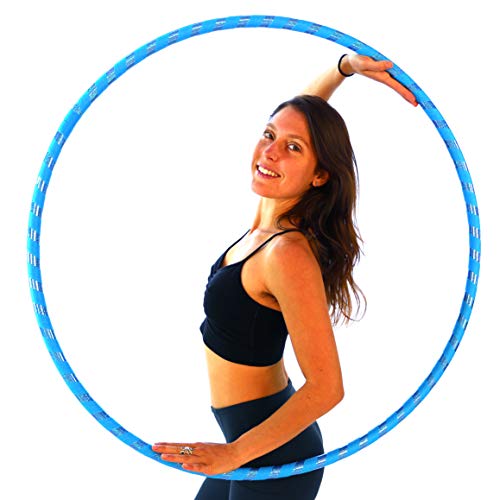TikTok users swear by weighted hula hoops for toning their core and burning calories—but do they really work? The short answer: Yes, and they’re making a major comeback as a go-to tool for fun, effective fat-burning workouts. The hashtag #weightedhulahoop has racked up millions of views, with users claiming the rhythmic, waist-spinning movement delivers serious results, especially when it comes to hula hoop weight loss.
Turns out, this playful fitness trend isn’t just hype. Using a weighted hula hoop can elevate your heart rate, strengthen your core, and help you torch calories—all without the joint strain of high-impact workouts, according to experts.
“Hula hooping makes moving fun and allows you to lose yourself in the flow,” says Kat Musni, CPT, a personal trainer and hoop fitness instructor with The Spinsterz. “It gets your heart rate up, so expect a cardio workout, and once you get more into the weighted hula hoops, you add a strength component.” More deets on all the benefits and how to get started with your first weighted hula hoop workout below.
Meet the experts: Kat Musni, CPT, is a personal trainer and hoop fitness instructor with The Spinsterz. Brittany Colbert, is a hula hoop instructor at Hoopologie and the founder of Honeysuckle Hooping.
In addition to the physical gains, hula hooping has serious mental health benefits. “Hula hooping is mindful, meditative, and creative,” says Brittany Colbert, a hula hoop instructor at Hoopologie and the founder of Honeysuckle Hooping. “Besides being a good workout, it clears the energy around you and makes you feel good.”
Ready to see what all the hoopla is about? Here’s what trainers have to say about how effective weighted hula hoops are, their benefits, and how to use the toy properly.
Do weighted hula hoops help with weight loss?
In short: Yes, weighted hula hoops can support weight loss goals while building strength and muscle tone. While it may look like a simple core workout, hula hooping engages much more than just your abs, according to research.
“Regular hooping around the waist mainly trains the core, the lumbar stabilizers of your spine, and your glutes,” says Musni. “If you start walking while hooping that adds an extra bonus for your legs, and if you start doing tricks with your arms, you add an awesome shoulder burn too.” So, beyond torching calories, weighted hula hoop workouts offer a full-body challenge, combining cardio with strength-building potential.
Research backs up these claims. Participants who used a weighted hula hoop (around 3.3 pounds) for six weeks, five days a week, saw reductions in waist and hip circumference and body fat compared to a control group, according to a study in the Journal of Strength and Conditioning.
Weighted hula hooping daily for six weeks can also reduce abdominal fat and increase muscle mass in the trunk area among obese individuals, according to a 2019 study in Obesity Facts. Compared to traditional cardio workouts like walking, the weighted hula hoop group showed greater improvements in both body composition and waistline measurements.
The appeal? Hula hooping feels more like play than exercise, which can help you stay consistent. “Hooping is a great introduction to fitness and moving because you’re able to lose yourself in the movement, it feels like dance, and it gets you into a flow or meditative state,” she says. And consistency is the name of the game when it comes to weight loss.
If you’re a hooping newbie, start with a lighter weight (about one pound) to get the hang of the movement. “Weighted hoops are especially great for beginners because they are heavier and slower which makes it easier to control,” says Musni. Think of it like strength training—begin light, master your form, and gradually progress.
How many calories can you burn with a weighted hula hoop?
Hula hooping isn’t just fun—it can torch a surprising number of calories. The average person burns approximately 210 calories in a 30-minute hula hoop workout, according to a study from the American Council on Exercise (ACE). That’s comparable to brisk walking at a 4 mph pace or moderate cycling.
If you up the intensity—adding squats, lunges, or arm movements while hooping—you can increase your calorie burn even more, inching closer to the calorie expenditure of jogging or aerobic dance classes (around 300-400 calories per half hour, depending on your weight and effort level), according to ACE.
Top Weighted Hula Hoop Benefits
Weighted hula hoops can help you build muscle and burn calories, but this specific form of movement comes with a few other perks, too.. Here are the head-to-toe benefits of working out with a weighted hula hoop, according to trainers and research:
- Improve balance. Hula hooping requires you to continuously shift back and forth, so you are constantly challenging your balance, says Musni. Research shows that balance is critical for all functional movements and essential for injury prevention.
- Reduce stress. Workouts can sometimes feel monotonous, but hula hooping is known to promote creativity and minimize stress. “When you’re hooping you are using both sides of your brain and you are able to connect with your body and mind, and check in with your emotions,” says Colbert. “You often don’t even realize you’re getting a workout, but it’s a great way to release endorphins and reduce stress.”
- Boost cardiovascular fitness. Hooping revs up your heart rate. “You’re usually so focused on getting the movement down that you don’t realize your heart rate is getting up there and you’re getting warm,” says Musni. Plus, cardiovascular (aerobic) exercise is critical for heart and lung health, weight management, and improving the flow of oxygen through the body, research shows.
- Work hand-eye coordination. Since you’re simultaneously challenging your brain and body in order to keep the hoop moving, you’re actively working on motor skills and hand-eye coordination, explains Musni. “Hand-eye coordination is not something you always think about, but you need to be very aware of where your body is at all times while hooping.”
- Build muscle. Anytime you use a hula hoop, you’re working your core, obliques, and lumbar spine, but don’t be surprised when your glutes, legs, and shoulders start burning too. “Once you get comfortable and start learning tricks, it’s a full body experience,” says Musni. You can add weights beyond the hoop, as well. If you’re looking to level-up, try wearing ankle or wrist weights for some extra resistance.
- Burn calories. If you’re looking to torch calories, research shows that hooping burns an average of 210 calories during a 30-minute workout. But whether you’re trying to lose weight or not, hooping is a great (and fun!) way to burn calories in a short amount of time, says Colbert. (Read: It’s efficient.)
5 Mistakes That Could Be Sabotaging Your Weighted Hula Hoop Workout
You might assume hula hooping is a child’s game and there’s no wrong way to do it. However, there are a few common mistakes to look out for. Here’s what trainers say are frequent hula hoop form problems and how to fix them:
- Using the wrong size. The size of your hula hoop is key to success. “Everybody’s body is a different shape and size, and a good hula hoop should reflect that,” says Colbert. While most hoops weigh between one and four pounds, the bigger the diameter of the hoop, the easier it is to spin.
Pro fix: “For beginners I definitely recommend using a lighter and bigger hoop that is at least up to your waist when you have it standing on the ground,” adds Musni. When you get more comfortable, increase difficulty with a smaller and/or heavier hoop.
- Twisting the hoop to gain momentum. “You should always have the hoop parallel to the ground when you first get started in the rotation,” says Musni. “A lot of people try to twist it on an angle, and we don’t want that because it’s automatically going to put it off kilter.”
Pro fix: Always maintain an upright posture and keep the hoop level with the ground.
- Releasing your core. It’s imperative to always engage your core to prevent injury, says Colbert. When you do it right, your abs will definitely feel the burn from all the flexing.
Pro fix: Keep your spine straight, core tight, and obliques activated to stay safe.
- Spinning with the hoop. “People think you want to spin with the hoop in a circle, but you really want to have a nice back and forth motion,” says Musni.
Pro fix: Instead of mimicking the hoop in a circular rotation, try pulsing back and forth.
- Overtraining. Hooping is fun, but you want to be mindful of overtraining. This is especially true with a weighted hula hoop, says Musni. Research shows that overtraining occurs when you don’t have adequate rest and recovery, so don’t overdo it! If you experience unusual muscle soreness, performance declines, or struggle to maintain other daily activities, that’s a sign to dial back your workouts.
Pro fix: Check in with your body regularly and give yourself breaks as needed.
- Straining your lower back. “Lower back injuries can be common if the muscles are not used to the repetitive motion,” explains Musni. Also remember to make sure that your hoop is not too heavy and you start with low weight, adds Colbert. “If you have a hoop that is too heavy it can hurt your spine with the weight swinging around your body.”
Pro fix: “Make sure to start out in small increments and build endurance day by day.”
- Overworking your shoulders. If you get comfortable and start to move the hoop on your arms, be mindful of shoulder overuse, says Musni. “When you start doing tricks with your shoulders it becomes a lot of anterior and lateral movements, so you want to make sure you work your rear delts outside of hooping to prevent injury.”
- Bruising. Hooping can unfortunately leave some battle wounds. “If you have a sensitive body, wear extra clothes or padding to help prevent bruising,” says Musni. Just make sure the clothing is tight-fitted to prevent any snags or tears from the hoop.
How To Use A Weighted Hula Hoop With Proper Form
Before you start spinning, it’s important to set yourself up for success. First, prep your space—weighted hula hoops can reach wider than you think, so opt for an open area (outside or in a clutter-free room) to avoid knocking into anything.
Next up: your ‘fit. Fitted, athletic clothing is key, says Colbert, who explains that baggy clothes can catch on the hoop and cause it to fall. Opt for leggings, a fitted tp, and snug layers to put a buffer between you and the hoop if you bruise easily.. As for shoes, it’s up to you! You can totally go barefoot, but if you choose to wear workout sneakers, be sure they are tied and double knotted.
Once your space and outfit are sorted, it’s time to hoop. Here’s how to nail proper form and advance as you build strength and coordination:
How to:
- Stand tall with a straight spine, shoulders down, toes facing forward, and feet shoulder-width, or one foot slightly staggered ahead (choose whichever stance feels more stable).
- Hold hoop around your waist, just above your hips, holding it with a light grip with both hands, parallel to the ground.
- Engage your core and toss the hoop to one side as you keep your feet planted on the ground.
- Pulse your hips and feet in a controlled rocking motion shifting your body forward and back. Keep your arms out to the side or above your head for an added challenge.
Beginner to advanced progressions:
- Beginner: Start with basic waist hooping for 1 to 2 minutes at a time. Focus on mastering the rocking motion and keeping the hoop spinning smoothly.
- Intermediate: Add movements like side-to-side steps, squats, or arm movements while hooping to engage more muscles.
- Advanced: Try walking forward and backward while hooping or practicing arm hooping (hooping around your arms) to really challenge coordination, cardio endurance, and upper body strength.
Ready to put it all together? Here’s a sample workout to get you started:
10-Minute Weighted Hula Hoop Workout
3 minutes: Basic waist hooping
- Focus on smooth, controlled rocking motion. Engage your core the entire time.
2 minutes: Step side-to-side while hooping
- Take small, rhythmic steps to each side without breaking the hoop’s spin.
2 minutes: Squat pulses while hooping
- Drop into a shallow squat and pulse up and down, keeping the hoop moving at your waist.
3 minutes: Arm hooping or walking while hooping
- Option 1: Transition to arm hooping (one arm at a time, if needed).
- Option 2: Walk slowly forward and backward while waist hooping for extra leg engagement.
Repeat as needed—or mix in your favorite moves—to build stamina and keep things fun.
What’s the best weighted hula hoop?
Ready to give hula hooping a spin? There are a few different types of weighted hula hoops out there, so it’s worth picking the right one based on your fitness goals and experience level.
Most weighted hoops range from one to five pounds—lighter hoops (around one to two pounds) are ideal for beginners because they spin more slowly, making it easier to maintain control and master your form. Heavier hoops (three or more pounds) provide more resistance and can up the strength-building challenge, but they require solid technique to avoid strain or bruising.
You’ll also find hoops in different sizes and materials, from foam-covered options for extra comfort to collapsible designs for easy storage. Some even come with add-ons like adjustable weights or detachable sections.
Check out a few top-rated weighted hula hoop options below to find one that fits your needs and skill level:
Andi Breitowich is a Chicago-based writer and graduate student at Northwestern Medill. She’s a mass consumer of social media and cares about women’s rights, holistic wellness, and non-stigmatizing reproductive care. As a former collegiate pole vaulter, she has a love for all things fitness and is currently obsessed with Peloton Tread workouts and hot yoga.

Jennifer Nied is the fitness editor at Women’s Health and has more than 10 years of experience in health and wellness journalism. She’s always out exploring—sweat-testing exercises and gear, hiking, snowboarding, running, and more—with her husband, daughter, and dog.
Read the full article here


